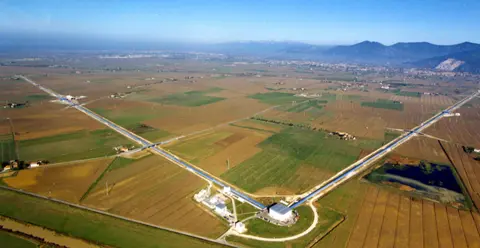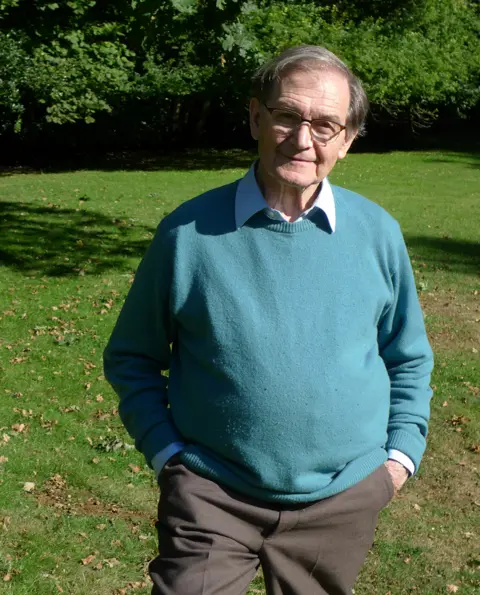Sir Roger Penrose: The man who proved black holes weren't 'impossible'
 ANTHONY HOWARTH/SCIENCE PHOTO LIBRARY
ANTHONY HOWARTH/SCIENCE PHOTO LIBRARYIf you ever struggled with maths at school, you were in good company. Sir Roger Penrose, who on Tuesday won the Nobel Prize for Physics, would also scratch his head in class.
"I was always very slow. I was good at maths, yes, but I didn't necessarily do very well in my tests," the Colchester-born (1931) laureate recalled.
"But the teacher realised if he gave me enough time, I would do well. I basically had to do everything by working it out from first principles."
Whoever that teacher was – and the lessons were in Canada during the war years – we have reason to thank him for his patience with the young pupil.
Sir Roger would go on to become a star at mathematics, first at University College London and then at Cambridge University, where he pursued his PhD.
Sir Roger was interested in topology - the mathematics that describes the properties of geometric objects as they are twisted or stretched. And it was this branch of maths that he would bring to bear on the problem of black holes – those extraordinary regions of space where matter has collapsed in on itself, and where gravity is so strong that nothing, not even light, can find a way out.
We take for granted today the ability of telescopes to image black holes, or at least their immediate vicinity. And we've become a little blasé, it has to be said, when laser interferometers "hear" yet another pair of black holes bump into each other and merge. And yet, go back just a few decades and the debate around the reality of black holes was a very heated one.
This was the cauldron into which Sir Roger jumped when he started applying some of the principles trained up in topology to black holes. Before his seminal 1965 paper, models could describe how these objects might form but they were often dismissed as being idealised situations with perfect symmetry that would be unlikely to occur in the "real world".
 LIGO-VIRGO Collaboration
LIGO-VIRGO CollaborationSir Roger's breakthrough was to use new approaches - including those topological tools - to show that a singularity, or a state of infinite density and pressure, would be a generic expectation, regardless of symmetry, if you had enough matter clumped together.
"I was thinking about the geometry of what goes on (inside these things we now call black holes) - how light rays behave, what they do when they start focusing, and can you stop them focusing, and that kind of thing," he explained.
"And I had general arguments which were pure mathematical, topological arguments - not the kind of thing people were using. And it was this idea, which I later called a trapped surface, which is a characterisation of when your collapse had reached a point of no return, roughly speaking, but it didn't depend on symmetry or anything like that. It was just a general characterisation that could tell you that something has gone funny."
If astronomers went out and looked in the right places, they would find the evidence, Sir Roger figured. From the remnants of exploded stars to the gargantuan features that lurk at the cores of most galaxies.
"While Einstein's general theory of relativity predicts the existence of black holes, Einstein didn't himself believe they really existed," said Prof Jim Al-Khalili, who interviewed Sir Roger for the BBC's The Life Scientific programme in 2016. "Penrose was the first to prove mathematically, in 1965, that they are a natural consequence of relativity theory and not just science fiction."


Whenever the general public thinks of black holes, it's often in the context of the late Stephen Hawking. And the pair spent a lot of time in the late 60s and 70s working on the same problems after being brought together by Hawking's PhD supervisor, Dennis Sciama.
Their lives ran on parallel tracks for many years.
Both came to wider attention through popular science writing.
For Hawking, it was A Brief History of Time that enabled him to punch through. And for Sir Roger, it was The Emperor's New Mind and The Road to Reality that built his connection to a lay audience. Although, while Hawking eschewed the use of equations in his books, Sir Roger liked to sprinkle just a few across the pages.
"I think it depends what sort of reader you're looking towards; I think my books perhaps attract a certain readership which is a bit different," he conceded.

 EHT
EHTWhat is a black hole?
- A black hole is a region of space where matter has collapsed in on itself
- The gravitational pull is so strong that nothing, not even light, can escape
- Black holes will emerge from the explosive demise of certain large stars
- But some are truly gargantuan, billions of times the mass of our Sun
- How these monsters - found at galaxy centres - formed is unknown
- Black holes are detected from the way they influence their surroundings
- They produce observable gravitational waves as they spiral in to each other

Where many people with no interest in science will recognise Sir Roger will be in the so-called "Penrose Staircase", or "Impossible Staircase". This is the fun optical illusion that depicts an ever-descending, or ascending, series of steps.
Sir Roger had become fascinated by the artist MC Escher after seeing some of his works at a mathematics congress in Amsterdam in the 1950s - and tried to fashion his own illusions.
"I tried to produce diagrams with roads and rivers and trains and things, which were impossible. And then I sort of simplified it into what I considered to be the essence of it, which was what they call a tri bar. It's just a triangle made of three rods stuck together in an impossible way. And I showed this to my father and he got fascinated by it and started to produce buildings, which were impossible, and finally came up with a staircase."
Father and son shared this idea with the Dutch artist, who would make the illusion famous in a lithograph print called Ascending and Descending, released in 1960.
 SPL
SPLThe Nobel Prize for Physics is the crowning achievement for Sir Roger who already has many awards to his name.
He may be 89, but he continues to fire out ideas across a broad range of topics – including in novel areas such as the application of quantum theory (the science of the smallest scales) to biology. Indeed, some of this thinking, such as in the origin of consciousness, has garnered quite some controversy.
One thing Sir Roger confesses he is unlikely ever to grasp, however - even with extra time - is the PowerPoint presentation. This will always remain a struggle, he says. Sir Roger much prefers the overhead projector.
"I do hate PowerPoint, it's true. I do use it occasionally and it's always a disaster."
Follow Jonathan on Twitter.
